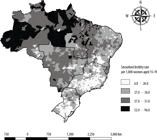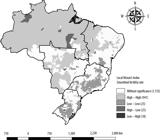Abstract
Objective
To identify socioeconomic and health care determinants of spatial variation in adolescent pregnancy in Brazil in 2014.
Methods
This was a spatial ecological study having municipalities as units of analysis. Spatial linear regression was used to verify association between the fertility rate in 15-19 year-old women and socioeconomic and health variables.
Results
The adolescent fertility rate was negatively associated with higher Family Health Strategy coverage (β = -0.011 – 95%CI -0.017;-0.005), an adequate number of prenatal consultations (β = -0.122 – 95%CI -0.132;-0.224) and low average family income per capita (β = -0.104 – 95%CI -0.105;-0.103). Association was positive in relation to the Gini index (β = 7.031 – 95%CI 4.793;9.269), low income (β = 0.127 – 95%CI 0.108;0.145), higher household density (β = 6.292 – 95%CI 5.062;7.522) and less schooling (β = 0.260 – 95%CI 0.224;0.295).
Conclusion
Reduced access to primary care and lower income are associated with higher adolescent fertility rates. Poorer socioeconomic and health care indicators are associated with higher adolescent fertility rates.
Pregnancy in Adolescence; Spatial Analysis; Socioeconomic Factors; Primary Health Care

 Thumbnail
Thumbnail
 Thumbnail
Thumbnail
 a) Assessed using Local Moran’s index, by assessing existence of clusters of similar values (high or low), assuming a p-value <0.05.b) Rate transformed using the empirical Bayesian method.
a) Assessed using Local Moran’s index, by assessing existence of clusters of similar values (high or low), assuming a p-value <0.05.b) Rate transformed using the empirical Bayesian method.
 a) Assessed using Local Moran’s index, by assessing existence of clusters of similar values (high or low), assuming a p-value <0.05.b) Rate transformed using the empirical Bayesian method.
a) Assessed using Local Moran’s index, by assessing existence of clusters of similar values (high or low), assuming a p-value <0.05.b) Rate transformed using the empirical Bayesian method.